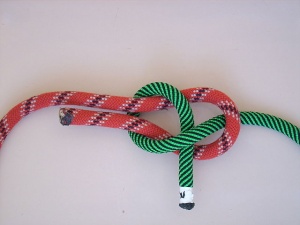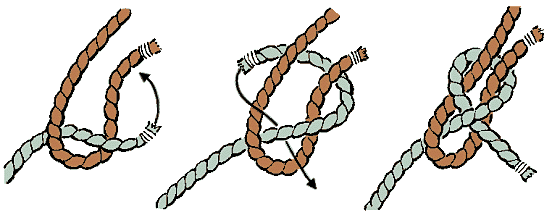Sheet Bend
The sheet bend (also known as becket bend, weaver's knot and weaver's hitch) is a bend, that is, a knot that joins two ropes together. Doubled, it is effective in binding lines of different diameter or rigidity securely together, although it has a tendency to work loose when not under load.
The sheet bend is related in structure to the bowline. It is very fast to tie, and along with the bowline and clove hitch is considered so essential it is knot №1 in the Ashley Book of Knots. It is a more secure replacement for the reef knot (square knot), especially in its doubled variety.
The sheet bend may be tied by various methods: the basic "rabbit through the hole" method of forming a half hitch in the bight of the larger rope, by a more expedient method shown in Ashley as №1431 (similar to the method used by an experienced sailor or mountaineer to tie a bowline) or by a trick method, Ashley №2562, involving upsetting a noose knot over a short end of the "larger" rope. (Lines of equal size may be joined with a sheet bend, of course, but when one is larger, it plays the simpler role of the red line shown in the infobox, rather than forming the nipped hitch as the green line does.) For maximum strength it is desirable to have the free ends on the same side of the knot.
One type of weaver's knot is topologically equivalent to a sheet bend, but is tied (usually in smaller stuff) with a different approach. Sheet bends are also used for netting. Notice that, in order to be most secure, the two free ends should end up on the same side of the knot.
Contents |
Steps
Videos
Usage
Joining two ropes of different diameters

